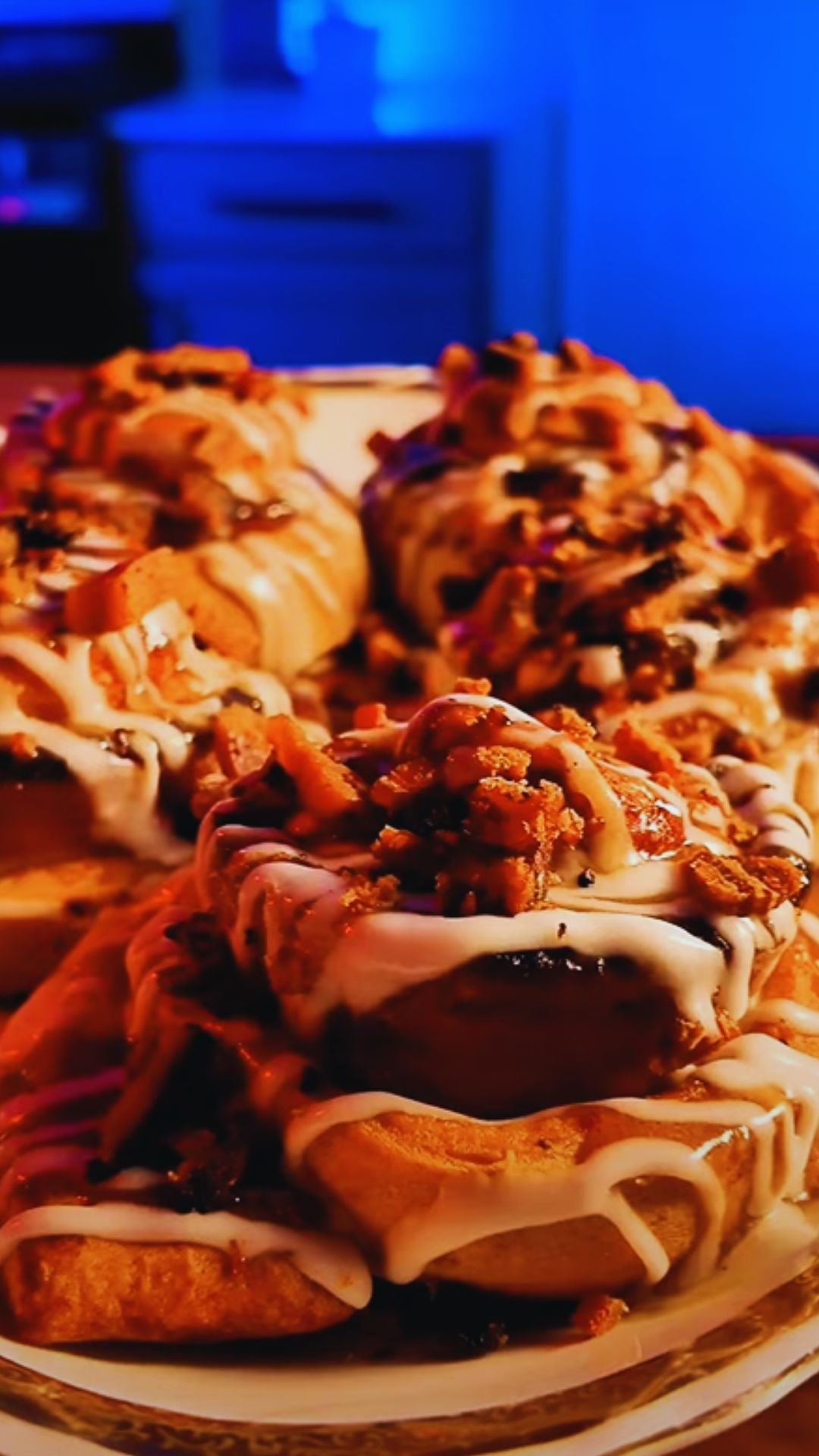Have you ever found yourself torn between the buttery layers of a croissant and the comforting bite of a cookie? I certainly have, and that’s exactly why I fell in love with almond croissant cookies the first time I made them. These incredible treats combine the best of both worlds—the flaky, buttery texture of croissants with the convenient form and satisfying chew of cookies, all enhanced with the rich flavor of almonds.
In my years of baking, I’ve discovered that hybrid desserts often capture the imagination and taste buds in unexpected ways. These almond croissant cookies are no exception. They’ve become my go-to recipe when I want to impress guests without spending hours in the kitchen folding dough for traditional croissants.
What Makes Almond Croissant Cookies Special?
What sets these cookies apart is their unique layered texture. Unlike traditional cookies that have a uniform consistency throughout, these cookies shatter into flaky layers when you bite into them, releasing buttery almond flavors that dance on your tongue. They have crispy edges, a slightly chewy middle, and that unmistakable croissant-like quality that makes them utterly irresistible.
The secret lies in the laminated dough technique—similar to what’s used for croissants but simplified for the home baker. Don’t worry if you’ve never attempted laminated dough before; my approach makes it approachable even for beginners. The result is a cookie that looks impressive but is actually quite straightforward to make.
The Origin Story
The inspiration for almond croissant cookies comes from the beloved almond croissant, a French pastry that transforms day-old croissants into something even more delicious by filling them with almond cream (frangipane) and topping them with sliced almonds. As the story goes, French bakers created almond croissants as a way to use up unsold plain croissants from the previous day—a brilliant example of reducing food waste while creating something magnificent.
My cookie version maintains the essence of this treat while making it more accessible. After many tests and tweaks in my kitchen, I’ve developed a recipe that captures that magical croissant quality without requiring specialized equipment or professional training.
Essential Ingredients
Before we dive into the recipe, let’s talk about what you’ll need. Quality ingredients make all the difference in these cookies:
- European-style butter: With its higher fat content, European butter creates better layers and flavor. I always keep this on hand for special baking projects.
- Almond flour: Fine almond flour adds moisture and that distinctive almond flavor that makes these cookies special.
- Almond extract: A small amount intensifies the almond character without overpowering.
- Good quality vanilla: Since vanilla is a background note here, use the best you can afford.
- All-purpose flour: The protein content in all-purpose flour gives us the right balance of structure and tenderness.
Let’s look at how these ingredients work together in this recipe:
| Ingredient | Amount | Function | Notes |
|---|---|---|---|
| European-style butter | 1 cup (226g) | Creates flaky layers, adds richness | Keep very cold until ready to use |
| All-purpose flour | 2 cups (240g) | Provides structure | Measure by weight for best results |
| Almond flour | 1 cup (96g) | Adds moisture, tenderness, and almond flavor | Use blanched, fine almond flour |
| Granulated sugar | ¾ cup (150g) | Sweetens, aids in browning | Can reduce to ⅔ cup for less sweetness |
| Salt | ½ tsp | Enhances flavor | Fine sea salt works best |
| Eggs | 2 large | Binds ingredients, adds richness | Room temperature for better incorporation |
| Almond extract | ½ tsp | Provides almond flavor | Use pure, not imitation |
| Vanilla extract | 1 tsp | Adds depth of flavor | Pure vanilla extract recommended |
| Sliced almonds | ½ cup (43g) | Garnish, adds texture | Toast lightly for enhanced flavor |
| Powdered sugar | 2 tbsp | Final dusting | Optional but recommended |
Equipment You’ll Need
- Stand mixer or hand mixer
- Rolling pin
- Baking sheets
- Parchment paper
- Pastry brush (for egg wash)
- Bench scraper (helpful but not essential)
- Cooling rack
- Kitchen scale (for best results)
Step-by-Step Process
Now, let’s get to the fun part! Here’s how to make these delightful cookies:
Preparing the Dough
- Prepare the butter block: Take ¾ cup (170g) of the cold butter and place it between two pieces of parchment paper. Roll it into a 6×9 inch rectangle about ¼ inch thick. Refrigerate this for at least 30 minutes until firm.
- Make the dough base: In the bowl of your stand mixer, combine the all-purpose flour, almond flour, sugar, and salt. Mix well.
- Add wet ingredients: Cut the remaining ¼ cup (56g) of butter into small cubes and add to the flour mixture. Mix on low speed until the mixture resembles coarse sand. Add the eggs, almond extract, and vanilla extract. Mix just until the dough comes together.
- Shape and chill: Form the dough into a rectangle, wrap it in plastic wrap, and refrigerate for at least 1 hour.
Laminating the Dough

This is where the magic happens. Laminating creates those beautiful, flaky layers that make these cookies so special:
- First fold: On a lightly floured surface, roll the chilled dough into a rectangle approximately 12×18 inches. Place the cold butter block on the bottom two-thirds of the dough, leaving a border around the edges.
- Fold like a letter: Fold the top third (unbuttered portion) of the dough down over the middle third. Then fold the bottom third up over both layers, like folding a business letter. Pinch the edges to seal.
- Turn and roll: Turn the dough 90 degrees. Roll it out again into a 12×18 inch rectangle. Fold into thirds again. This completes the first “turn.”
- Repeat: Wrap the dough and refrigerate for 30 minutes. Repeat the rolling and folding process two more times, chilling between each turn. After the final turn, refrigerate the dough for at least 2 hours or overnight.
Shaping and Baking
- Prepare for baking: Preheat your oven to 375°F (190°C). Line baking sheets with parchment paper.
- Roll and cut: On a lightly floured surface, roll the chilled dough to about ¼ inch thickness. Cut into 2½-inch rounds using a cookie cutter.
- Add toppings: Brush the tops with beaten egg, then sprinkle with sliced almonds, pressing them gently into the surface.
- Bake to perfection: Bake for 15-18 minutes, until the cookies are golden brown and the edges are crisp. They should look like tiny, puffy discs with visible layers on the sides.
- Cool and finish: Let cool on the baking sheets for 5 minutes, then transfer to a wire rack. Once completely cool, dust lightly with powdered sugar.
Tips for Success
Over my many batches of these cookies, I’ve discovered several tricks that make a big difference:
- Temperature matters: Keep everything cold! If at any point your dough becomes too soft or the butter starts to melt, return it to the refrigerator immediately.
- Don’t overwork the dough: Handle the dough as little as possible to prevent the gluten from developing too much, which would make the cookies tough.
- Count your folds: Each fold multiplies the number of layers in your dough. Three folds will give you plenty of flaky layers.
- Even thickness: Try to roll the dough to an even thickness to ensure all cookies bake at the same rate.
- Watch the bake time: These cookies can go from perfectly golden to overdone quickly. Start checking at the minimum bake time.
- Make ahead: The dough can be prepared up to 2 days in advance and kept refrigerated, or frozen for up to 1 month.
Troubleshooting Common Issues
Even experienced bakers encounter challenges. Here are solutions to common problems you might face:
| Issue | Cause | Solution |
|---|---|---|
| Butter leaking out during baking | Dough or butter too warm | Chill dough longer before baking |
| Cookies not flaky enough | Insufficient lamination | Make sure to complete all three turns |
| Dough too sticky to work with | Not enough chilling time | Refrigerate longer; use minimal flour for rolling |
| Cookies spreading too much | Butter too soft or oven not hot enough | Chill shaped cookies before baking; check oven temperature |
| Uneven browning | Oven hot spots | Rotate baking sheets halfway through baking |
| Almonds falling off | Not pressed into dough enough | Press almonds firmly into egg wash before baking |
Variations to Try
Once you’ve mastered the basic recipe, get creative with these delicious variations:
Chocolate Almond
Add ¼ cup cocoa powder to the dough and fold in ½ cup mini chocolate chips with the final turn. Drizzle baked cookies with melted chocolate.
Citrus Almond
Add 1 tablespoon of lemon or orange zest to the dough. After baking, brush with a glaze made from powdered sugar and fresh citrus juice.
Spiced Almond
Add ½ teaspoon each of cinnamon and cardamom to the dough. Sprinkle cookies with cinnamon sugar before baking instead of almonds.
Raspberry Almond
Roll out the final dough, spread with a thin layer of raspberry jam, then roll up like a log and slice into pinwheels before baking.

Storage and Shelf Life
These cookies are best enjoyed on the day they’re baked, when the contrast between the crisp exterior and tender interior is at its peak. However, they can be stored in an airtight container at room temperature for up to 3 days.
For longer storage, these cookies freeze beautifully:
- Place completely cooled cookies in a single layer on a baking sheet and freeze until solid.
- Transfer to an airtight container or freezer bag, separating layers with parchment paper.
- Freeze for up to 2 months.
- Thaw at room temperature for about 30 minutes before serving.
Serving Suggestions
Here are my favorite ways to serve these special cookies:
- With a cup of strong coffee or espresso for an authentic French café experience
- Alongside a scoop of vanilla bean ice cream for a delightful dessert
- As part of a brunch spread with fresh fruit and yogurt
- Packaged in a beautiful box for a homemade gift
- Arranged on a tiered stand for afternoon tea
Complete Recipe

Almond Croissant Cookies
Prep Time: 1 hour (plus 3-4 hours chilling)
Bake Time: 15-18 minutes
Yield: 24 cookies
Ingredients:
- 1 cup (226g) European-style butter, cold and divided
- 2 cups (240g) all-purpose flour
- 1 cup (96g) fine almond flour
- ¾ cup (150g) granulated sugar
- ½ teaspoon fine sea salt
- 2 large eggs, room temperature (plus 1 for egg wash)
- ½ teaspoon pure almond extract
- 1 teaspoon pure vanilla extract
- ½ cup (43g) sliced almonds
- 2 tablespoons powdered sugar for dusting
Instructions:
- Prepare the butter block: Place ¾ cup (170g) cold butter between parchment paper. Roll into a 6×9 inch rectangle. Refrigerate for 30 minutes.
- Make the dough: In a stand mixer, combine all-purpose flour, almond flour, sugar, and salt. Add remaining ¼ cup (56g) cubed butter and mix until sandy. Add 2 eggs, almond extract, and vanilla extract. Mix just until dough forms.
- Shape dough into a rectangle, wrap in plastic, and refrigerate for 1 hour.
- First lamination: Roll chilled dough into a 12×18 inch rectangle. Place cold butter block on bottom two-thirds, leaving a border. Fold top third down and bottom third up, like a letter. Pinch edges to seal.
- Turn dough 90 degrees. Roll into a 12×18 inch rectangle again. Fold into thirds. Refrigerate for 30 minutes.
- Repeat the rolling and folding process twice more, chilling for 30 minutes between each turn. After the final turn, refrigerate for at least 2 hours or overnight.
- Preheat oven to 375°F (190°C). Line baking sheets with parchment paper.
- Roll chilled dough to ¼ inch thickness. Cut into 2½-inch rounds.
- Beat remaining egg and brush tops of cookies. Sprinkle with sliced almonds, pressing gently to adhere.
- Bake for 15-18 minutes until golden brown with crisp edges.
- Cool on baking sheets for 5 minutes, then transfer to a wire rack.
- When completely cool, dust with powdered sugar.
Nutritional Information
For those watching their intake, here’s the nutritional breakdown per cookie:
| Nutrient | Amount per Cookie |
|---|---|
| Calories | 178 |
| Total Fat | 12g |
| Saturated Fat | 6g |
| Cholesterol | 42mg |
| Sodium | 84mg |
| Total Carbohydrates | 16g |
| Dietary Fiber | 1g |
| Sugars | 8g |
| Protein | 3g |
Why These Cookies Will Become Your New Favorite
There’s something deeply satisfying about mastering a recipe that looks and tastes impressive but doesn’t require professional training. These almond croissant cookies are just such a recipe. They capture the essence of a beloved French pastry in a form that’s more approachable, both to make and to eat.
I love bringing these cookies to gatherings because they always spark conversation. People are intrigued by their unique texture and the familiar-yet-different almond flavor. They’re substantial enough to be satisfying but delicate enough to feel special.
What I find most rewarding about baking these cookies is watching someone take that first bite—there’s always a moment of surprise and delight as they discover the flaky layers and rich almond flavor. It’s the kind of reaction that makes all the folding and chilling worthwhile.
Frequently Asked Questions
Q: Can I use regular butter instead of European-style butter?
Yes, you can use regular unsalted butter, though the cookies might not be quite as rich and flaky. European-style butter has a higher fat content (82-86% compared to American butter’s 80%), which creates better layers and flavor.
Q: Is there a shortcut for making these cookies?
While the lamination process is what makes these cookies special, you can reduce the number of folds to two instead of three if you’re short on time. The cookies will have fewer layers but will still be delicious.
Q: Can I make these cookies without almond flour?
The almond flour is pretty important for both texture and flavor. In a pinch, you could substitute finely ground toasted almonds, but I wouldn’t recommend replacing it with all-purpose flour as the cookies would lose their distinctive character.
Q: Why did my cookies not rise as much as expected?
Several factors could affect the rise: if your butter melted during the lamination process, if the dough wasn’t chilled enough before baking, or if your oven temperature isn’t accurate. Using an oven thermometer and keeping everything cold throughout the process helps.
Q: Can I make these cookies gluten-free?
I haven’t tested a gluten-free version, but you might try substituting a cup-for-cup gluten-free flour blend. The lamination process might be more challenging without gluten, so the texture could be different.
Q: How do I store the dough if I want to make the cookies over several days?
The fully laminated dough can be wrapped tightly in plastic wrap and refrigerated for up to 3 days. You can also freeze it for up to a month. Thaw overnight in the refrigerator before rolling and cutting.
Q: My kitchen is very warm. Any special tips?
If your kitchen is warm, work quickly and use the refrigerator liberally. You might even chill your rolling pin, work surface, and flour before starting. Consider rolling the dough between sheets of parchment paper to minimize sticking.
Q: Can I double the recipe?
Yes, the recipe doubles well. Just be sure to work with half the dough at a time to keep everything properly chilled.
I hope you enjoy making these almond croissant cookies as much as I do. They’re truly a special treat that bridges the gap between everyday cookies and fancy French pastry. Happy baking!


